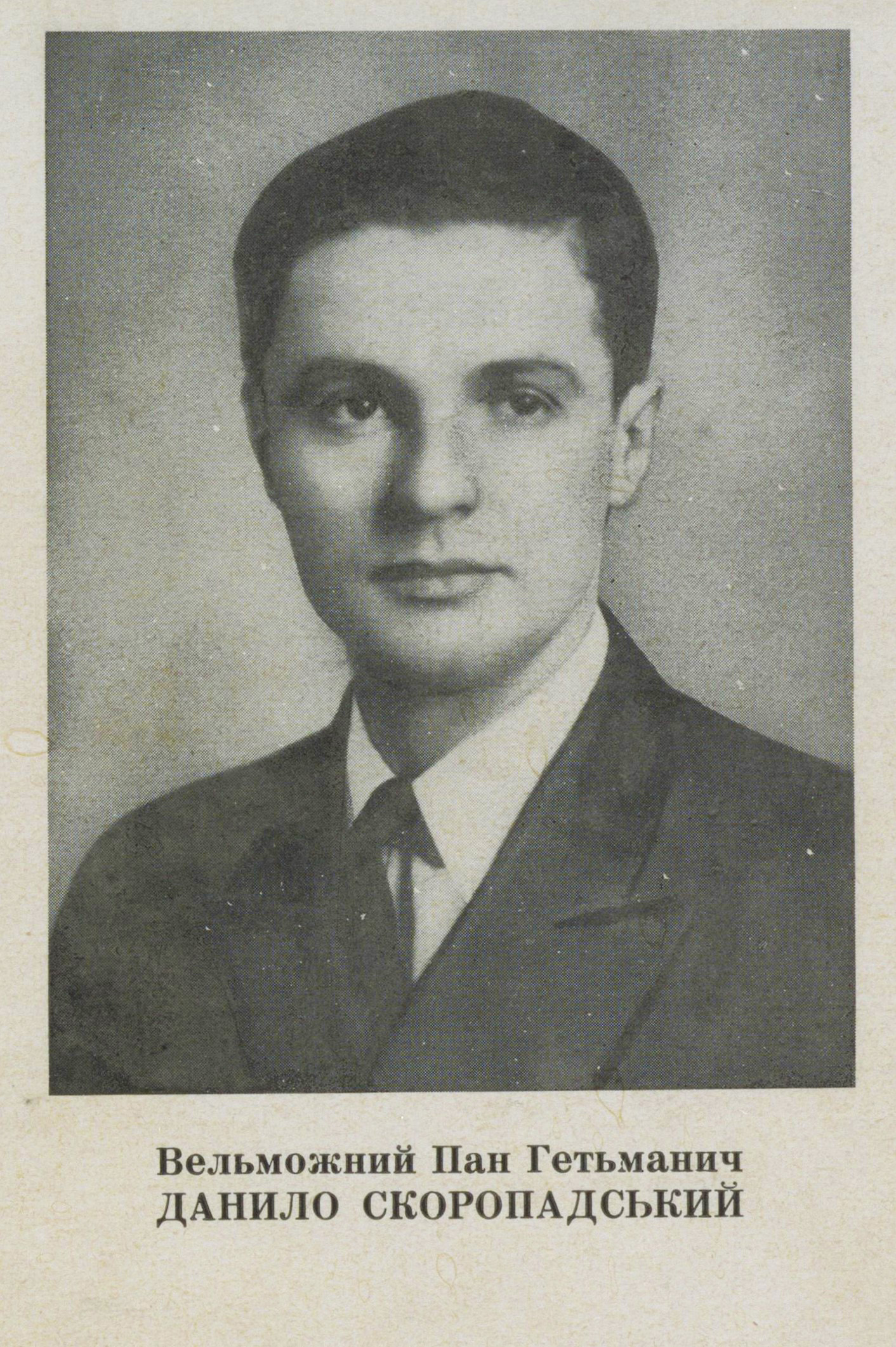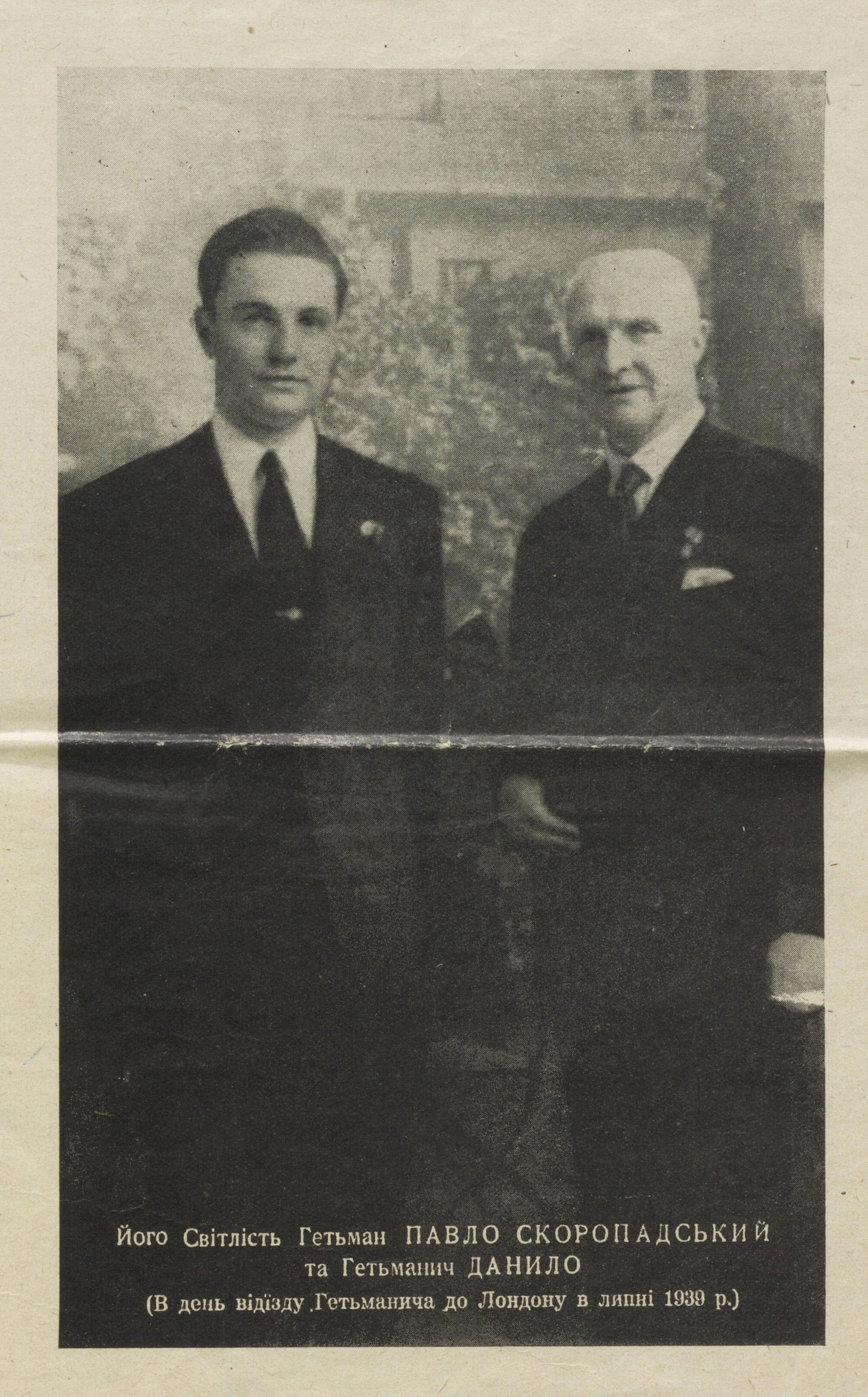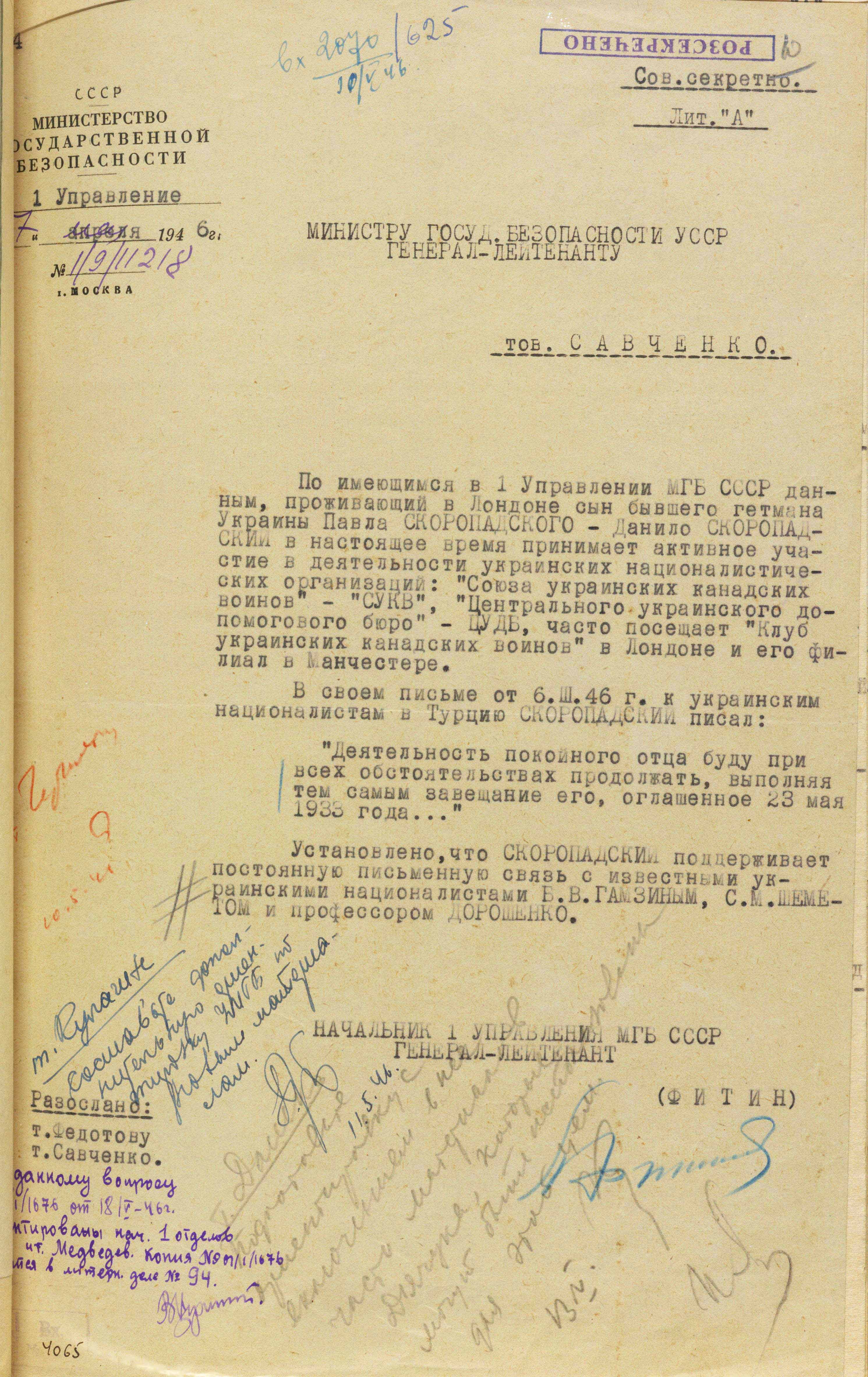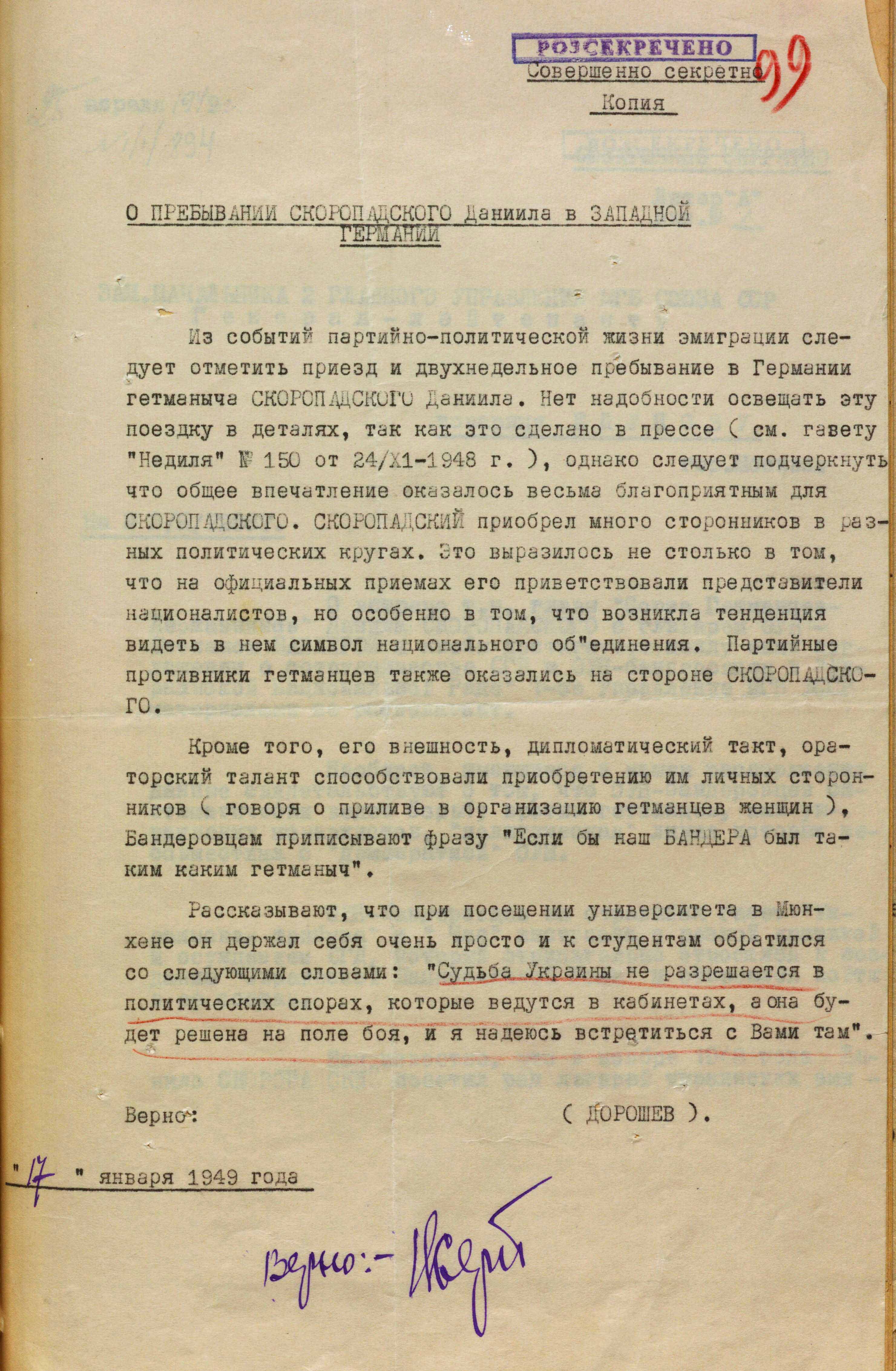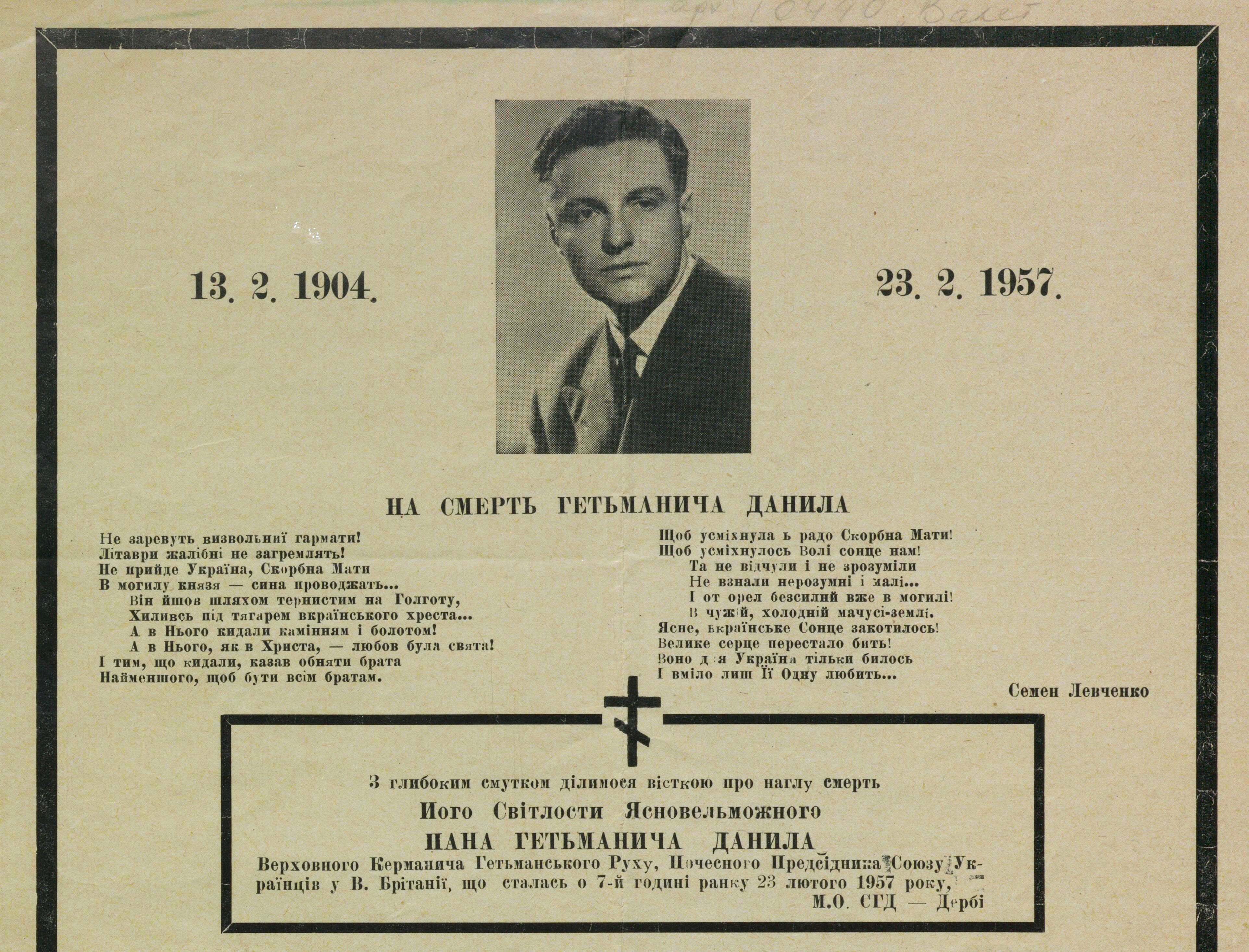Danylo Skoropadskyi. The “Knave” in the ussr mgb’s Deck of Cards
2/13/2024
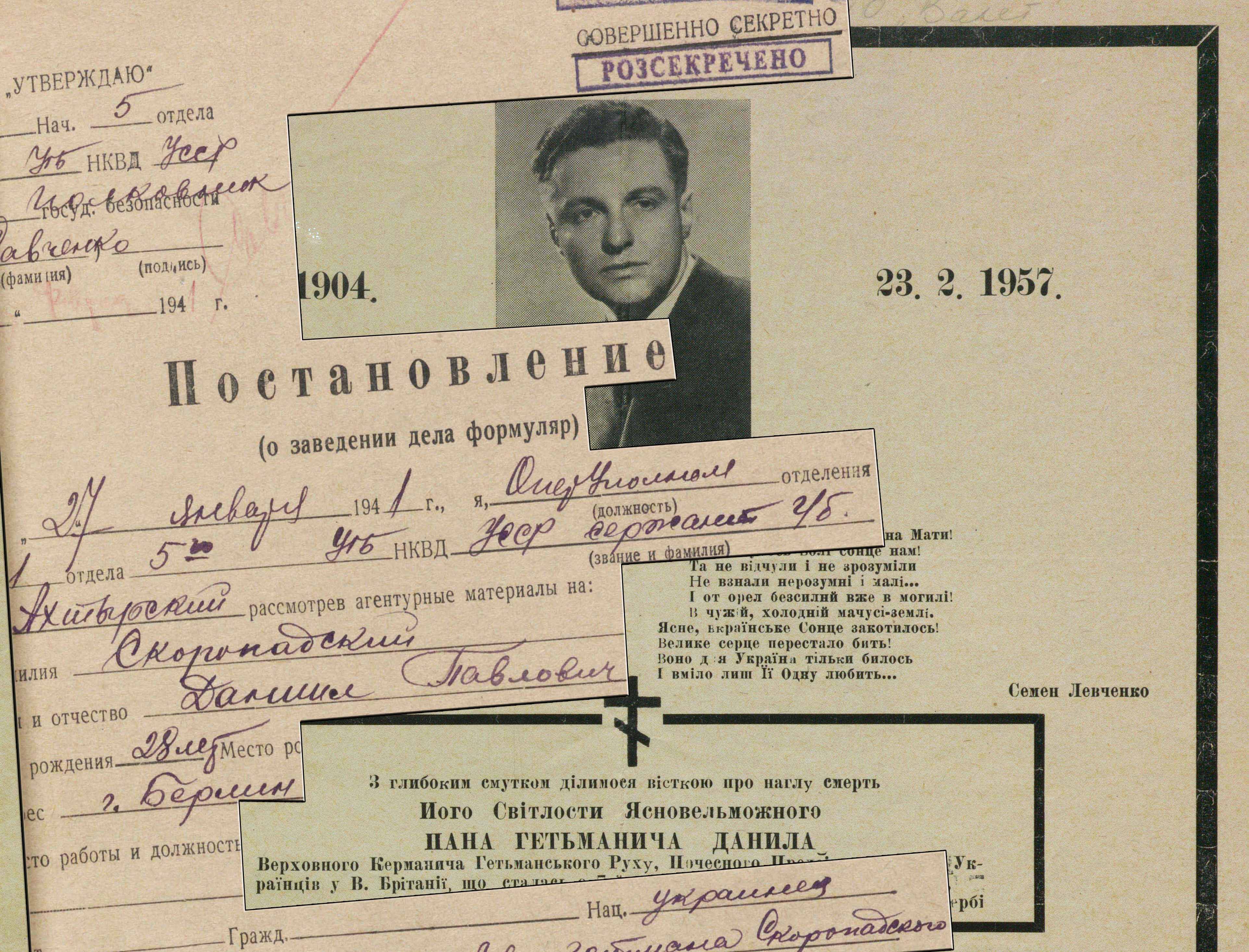
February 13 marks 120 years since the birth of Danylo Skoropadskyi. Archival documents of soviet special services paid much less attention to him than to his father – Hetman Pavlo Skoropadskyi. At the same time, declassified documents show that having headed the Hetmanite movement, he also caused a lot of trouble to the chekists.
A Promising Engineer at Siemens Plant
In the 1920s and 1930s, when the ussr ogpu was carrying out the operational cultivation of Hetman Pavlo Skoropadskyi and the Hetman's government, it did not pay any special attention to Hetmanych (Hetman’s son and heir- Transl.) Danylo. Among the documents in the archive of the Foreign Intelligence Service of Ukraine of that period there are only messages and characteristics of a general nature.
One of the first documents mentioning him is dated November 1928. In it, ogpu's foreign agent reports that Danylo has created a Society of the Dnieper Ukraine Engineers in Berlin and is going to find contacts in Ukraine, in particular in Kyiv, to exchange information of a technical nature. The report also states that this idea was fully approved by Hetman Skoropadskyi.
During that period, Danylo studied at the Higher Technical School in Charlottenburg (later - Berlin Technical University) and took an active part in student life. After graduation, he got a job at the Electrotechnical Factory of Siemens and Halske. The other document states this: “The Hetman’s son, Danylo, has graduated from the machine -building department of the Higher Technical School in Berlin and is currently being practicing at the Siemens Plant in Berlin. He settled there through one German who commanded a squadron in the regiment, which was commanded by Skoropadskyi. This German is married to the niece of the head of Siemens and is the sole heir to the owner of the firm” (BSA of the SZR of Ukraine. - F.1. – Case 10490. - Vol. 1 - P. 46).
At that time, the chekists were starting to look closer at Hetmanych trying to predict what place next to his father he would take in the future. “D. P. Skoropadskyi,- reads the “Characteristics of the Hetmanite Center’s Figures”, – is a young man who has recently graduated from the institute, works at the Siemens plant as an engineer-designer, and is still little versed in political affairs; attends all meetings of the Hetman's Uprava (administration- Transl.) as a legitimate heir; enters the course of affairs gradually, almost does not make proposals, just listens; in order to bring him into the course of affairs, he was instructed to engage in Hetmanite organizations; in fact, all the work is done by S.M. Sh.(Serhiy Shemet- Note), while he just signs the papers.(BSA of the SZR of Ukraine, F.1, Case 10490, Vol.1, P. 32)
During that period, the chekists for several years had been conducting operation cultivation of the Hetman’s Uprava. They tried to find out plans, intentions, combat organizations and the capability of taking active actions against soviet authorities. Eventually, as one of the documents states, they concluded that the Hetmanite movement is still “a certain potential danger to the integrity of the soviet union”, but it is dominated by the patriarchal spirit and only Hetmanych Danylo is surrounded by more progressive representatives of the movement. These conclusions were supported by D. Skoropadskyi's great diplomatic success during his trip to the USA and Canada.
“A 33-Year-Old Prince of Ukraine”
In 1937-1938, Danylo, on behalf of his father, made a four-month visit to the USA and Canada. The aim was to strengthen the positions of the Hetmanite movement overseas, where Ukrainian diaspora at that time was the most numerous. During that journey, he held many meetings with members of Hetmanite organizations, as well as Ukrainians of different political directions.
There are many materials about that visit in the Intelligence’s archival funds. For the most part, – correspondence between Pavlo Skoropadskyi and his son, which fell into the hands of the nkgb of the ussr after World War II. The chekists found a large number of materials of the Hetman's Uprava in the process of sorting out the archives of the Ministry of Internal Affairs of Germany. Most of those documents are dated 1935–1939. Including the letters that Danylo wrote during his stay in the United States and Canada, in which he informed about the current state of affairs of the Union of Hetmanists-State-Builders and commented on events in the world. Besides, there are messages, articles and other publications about Danylo's stay abroad, as well as some reports of foreign agents.
The first meeting with the Hetmanych was held in Chicago. He arrived there on the occasion of the blessing of the Ukrainian aircraft “Kyiv”, one of the three, which the Hetmanite community purchased for raised funds for training Ukrainian pilots. Danylo impressed all those present with a refined Ukrainian speech, his erudition and manners.
The archival documents quote his speech at the celebration of the Ukrainian Day, which took place on October 19, 1937. “I address you not only as a representative of my father and Hetmanists on the European continent”, reads the paper, “but as a Ukrainian, originally from Greater Ukraine, who in soul and body desires that the two branches – eastern and western - of the Ukrainian people – get united as soon as possible for a joint struggle for the formation of their independent Ukrainian state” (BSA of the SZR of Ukraine. - F.1. – Case 10490. - Vol. 2 - P. 19).
One of the papers emphasizes that the receptions and meetings, unlike the previous ones, were attended by representatives of all Ukrainian parties who had never gathered together before and had nothing in common. According to the paper, the summery of all said by Hetmanych Danylo can be reduced to the following:
“All Ukrainians should have as a goal the ideal of a sovereign and independent Ukrainian state. The Ukrainian people can achieve this ideal solely on their own. To do this, the forces must be prepared and organized. The preparation of the Ukrainian people for independent state life should be based on cultivating the spirit of activity, sacrifice, morality and national unity...
He emphasized the importance of national culture as a ground for uniting all Ukrainians…
He also stressed that the main enemy, interfering with the achievement of the Ukrainian ideal, is the bolsheviks, and therefore the struggle against bolshevism everywhere is a sacred duty of Ukrainian patriots”. (BSA of the SZR of Ukraine, F.1, Case 10490, Vol. 2, P. 24–25).
The entire overseas press wrote about such speeches and statements of the Hetmanych, and his position was well known. At the same time, the special message of the ussr nkvd of December 29, 1937 entitled “On Hetmanists’ Military Work in America”, addressed to the chief of the nkvd nikolai yezhov and signed by the foreign department officers Sergei Shpigelglas and Pavel Sudoplatov, discloses hitherto unknown facts. Like, for example, that D. Skoropadskyi launched active work among Ukrainian emigrees aimed at training military personnel.
“To this end, on Lake Michigan”, the special message says, “a military base has been created, where the Ukrainian Legion is formed from former servicemen of the Ukrainian Army.
The base has submarines of outdated samples, tanks, planes and military equipment for the training of military specialists.
The Hetmanite Group in America is subsidized by American financiers, Ford for one”(BSA of the SZR of Ukraine. - F.1. – Case 10490. - Vol. 1 - P. 5).
No additional information that could specify this really important report on the preparation of Ukrainians on Lake Michigan has been found. But there is a mention of D. Skoropadskyi’ visiting Ford’s plants in Detroit. “Old Ford”, one of the documents says, “met the Hetmanych and for almost half an hour talked with him on political topics. He asked about Ukraine, Germany, bolsheviks. Then he personally went to show the Hetmanych the school and the club for workers” (BSA of the SZR of Ukraine. - F.1. – Case 10490. - Vol. 2 - P. 22).
Another paper tells about D. Skoropadskyi’s meeting in Stratford with aircraft designer Ihor Sikorsky and Danylo’s letter to his father about that meeting dated August 24, 1938. In it, Danylo retells Sikorskyi's story about his Ukrainian roots, how he began to create planes and about the US Aviation Factory in the United States, where large hydroplanes are made. He points out that Sikorskyi later showed him the factory, and Danylo saw with his own eyes the construction of aircrafts. He further reports that Sikorskyi plans a trip to Berlin and wants to meet Pavlo Skoropadskyi there. At this, Danylo points out: “Sikorskyi presents himself as a great anti-bolshevik. His opinion is to seek cooperation with all anti-bolshevik elements, including with Ukrainians. I am telling all this just for your information”(BSA of the SZR of Ukraine. - F.1. – Case 7242. - Vol. 18. - P. 1_ZV.).
All this information about Danylo Skoropadskyi's successful trip to the United States and Canada, along with the opening of a number of pilot schools for the preparation of Ukrainian pilots and training Ukrainian emigrants at a military base on Lake Michigan was quite a concern for the nkvd leadership. The emotional statements of the press about the official heir to the Hetman's throne were also alarming.
“Tall, slender, heavily built, famous sportsman, courageous and affectionate, energetic in movements and language, calm, but decisive, reserved, respectful, but not cold, elegant from the outside and in relations with people, free in behavior, and at that full of true Hetman's respect. He led the Ukrainians”, - that’s what one of newspapers wrote of him. And another pointed out that “the 33-year-old Prince of Ukraine one day can become a central figure in a large uprising, on which the fate of Europe and Ukraine may depend”.
The Object of Operational Cultivation “Valet” (Knave -Transl.)
Upon Danylo’s return to Europe, Hetman Pavlo Skoropadskyi decided to send the Hetmanych to the United Kingdom and to transfer in the future the Hetmanite Center there. With each year coming, the heir to the Hetman's throne, according to archival documents, kept gaining political weight, authority and popularity. Therefore, on January 27, 1941, a separate case-file was opened on Danylo by the 5th departmment (foreign intelligence) of the state security directorate of the Ukrainian ssr. The resolution on the case stated that “Skoropadskyi Danylo is currently actively working among Ukrainian nationalists against the ussr”. The object of cultivation was given the codename “Valet”.
Archival documents do not contain any detailed information on Danylo Skoropadskyi’s activity during the Second World War. There is only a short statement: “During the war of 1941–1945 he carried out nationalist work in England… After the war and his father’s death, Skoropadskyi D.P. remained in London, headed the work of the Union of Hetmanists –State- Builders and conducts active anti -soviet activity” (BSA of the CZR of Ukraine. - F.1. – Case 10490. - Vol. 2 - P. 103).
At the time of the Hetmanych’s arrival in Great Britain, there were few Ukrainian emigrants there. Therefore, it was not easy for him to form an organized Ukrainian movement. After World War II, the number of Ukrainian emigration in the country has grown significantly. There arrived about 40,000 refugees from the ussr, including members of the OUN and UPA soldiers. Soon the Ukrainian diaspora became one of the most numerous in Europe.
During that period, D. Skoropadskyi actually took over the functions of the leader of the Hetmanite movement. One of the main problems facing him was the creation of a Union of Ukrainians in the United Kingdom. The Union was created in 1946 in Edinburgh. Soon Danylo, as one of the main organizers of the Union, became its unchanged Honorary Head.
In moscow, it was concluded that D. Skoropadskyi was becoming an increasingly important figure in the environment of Ukrainian emigrants. This is in particular evidenced by a letter from the chief of the 1st directorate (foreign intelligence) of the ussr mgb Pavel Fitin to minister of state security of the Ukrainian ssr Vasyl Savchenko of May 7, 1946. The letter says that Danylo is actively engaged in the work of Ukrainian nationalist organizations, in particular of the Union of Ukrainian Canadian Warriors, the Central Ukrainian Aid Bureau and others, often attends the Club of Ukrainian Canadian Warriors in London and its branch in Manchester.
The document contains an excerpt from the intercepted D. Skoropadskyi’s letter to the Ukrainian community in Turkey, in which he wrote: “Under any circumstances, I will continue my late father’s activity, thus performing his will, declared on May 23, 1933”. In addition, it is noted that he “maintains a constant written connection with well -known Ukrainian nationalists V.V. Homzin, S.M. Shemet and Professor Doroshenko” (BSA of the SZR of Ukraine. - F.1. – Case 10490. - Vol. 2. - P. 10).
Following such circulars from moscow, the mgb of the Ukrainian ssr decided to open another case on D. Skoropadskyi as a “Ukrainian nationalist”. This meant involvement of the agents in England and other countries, control of postal items, etc.
The mgb monitored Danylo's visit to Germany in October -November 1948. Then he visited the Ukrainian Free University, the Ukrainian Free Academy of Sciences in Munich, as well as Ukrainian camps for displaced persons in Freiman and Augsburg, and held numerous meetings with well-known Ukrainian figures, with Stepan Bandera included.
As noted in the archival documents, on November 6, 1948, D. Skoropadskyi arrived in the city of Augsburg, accompanied by several of his party members and met with Stepan Bandera. As a result of the negotiations between them, the agreement on cooperation between the Union of Hetmanists- State Builders and the OUN- Banderites was reached in the Ukrainian National Council.
During that period, the UPR leaders in exile and other formations created the UPRada, which was proclaimed the only representative body of the Ukrainian movement in emigration. The union of Hetmanists- State Builders was not presented in the Council. The Hetmanists then offered their own structure of the UPRada so that it contains all four forces available at that time in the Ukrainian movement, which were presented by Andriy Livytskyi, Andriy Melnyk, Stepan Bandera and Danylo Skoropadskyi. However, the call for cooperation and mutual understanding did not have the desired consequences. Therefore, D. Skoropadskyi, who always advocated unity in the Ukrainian liberation movement, agreed to meet with S. Bandera to find ways of understanding.
The mgb thoroughly monitored other contacts as well. The paper entitled “On Danylo Skoropadskyi’s Stay in Western Germany”, which came from moscow to Kyiv in December 1948, says that he had acquired many supporters among various political circles thanks to that trip. “This manifested itself”, the document reads, “not so much in the fact that at official receptions he was greeted by nationalists, but especially in the fact that there was a tendency to see in him a symbol of national unity. Party opponents of the Hetmanists also found themselves on the side of Skoropadskyi. In addition, his appearance, diplomatic tact, oratorical talent contributed to the acquisition of personal supporters (after the statement on women becoming members of the organization of Hetmanists). The Banderites are attributed the phrase: “We wish our Bandera were like the Hetmanych”.
Apart from this information, the document focuses on the Hetmanych’s speech before Ukrainian students of the University of Munich, during which he stated: “The fate of Ukraine is not being resolved in political disputes that take place in offices. The fate of Ukraine will be resolved on the battlefield, and I hope to see you there” (BSA of the SZR of Ukraine. - F.1. – Case 10490. - Vol. 2 - P. 99).
Such information forced the mgb, and then - kgb, even more thoroughly to monitor D. Skoropadskyi, prevent the unification of Ukrainian forces and make a split in relations between them. Many operational measures were taken at that period from the standpoint of the mgb central apparatus in moscow, which had more agents in the United Kingdom. But there is no information about their character and the last years of the Hetmanych’s life in the archival funds of the SZRU.
It is known from open sources that on February 22, 1957, after a dinner at a restaurant in the family circle, Danylo Skoropadskyi suddenly felt unwell. The next day he died. He died in the prime of life, being in good health. He was only 52 years old. The medical report stated that the cause of death was hemorrhage into the brain, although the posthumous autopsy was not done. Close relatives did not insist on it.
The resolution on the transfer of the case to the archive, approved by the management of the kgb under the council of ministers of the soviet Ukraine, briefly states that D. Skoropadskyi died in February 1957 in one of London's clinics.

